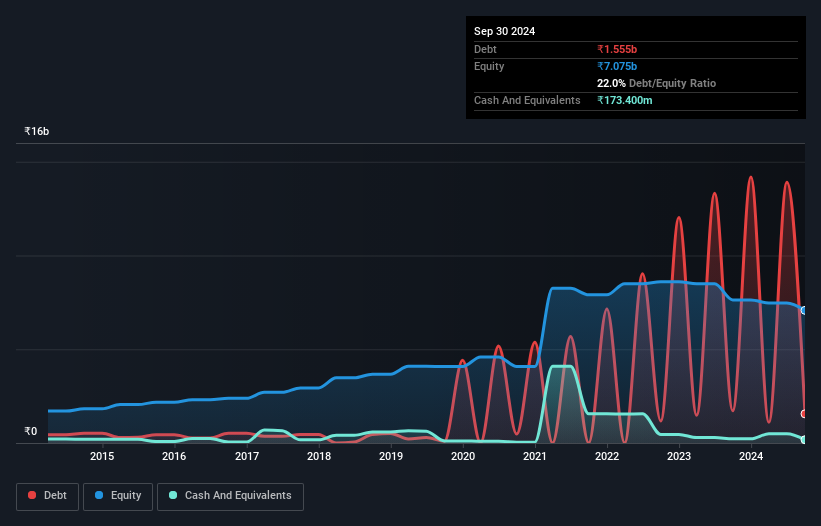- India
- /
- General Merchandise and Department Stores
- /
- NSEI:VMART
We Think V-Mart Retail (NSE:VMART) Can Stay On Top Of Its Debt
Warren Buffett famously said, 'Volatility is far from synonymous with risk.' So it seems the smart money knows that debt - which is usually involved in bankruptcies - is a very important factor, when you assess how risky a company is. Importantly, V-Mart Retail Limited (NSE:VMART) does carry debt. But the real question is whether this debt is making the company risky.
Why Does Debt Bring Risk?
Generally speaking, debt only becomes a real problem when a company can't easily pay it off, either by raising capital or with its own cash flow. In the worst case scenario, a company can go bankrupt if it cannot pay its creditors. However, a more usual (but still expensive) situation is where a company must dilute shareholders at a cheap share price simply to get debt under control. Of course, debt can be an important tool in businesses, particularly capital heavy businesses. When we examine debt levels, we first consider both cash and debt levels, together.
Check out our latest analysis for V-Mart Retail
How Much Debt Does V-Mart Retail Carry?
As you can see below, V-Mart Retail had ₹1.55b of debt at September 2024, down from ₹1.72b a year prior. On the flip side, it has ₹173.4m in cash leading to net debt of about ₹1.38b.

How Strong Is V-Mart Retail's Balance Sheet?
The latest balance sheet data shows that V-Mart Retail had liabilities of ₹10.3b due within a year, and liabilities of ₹13.6b falling due after that. Offsetting these obligations, it had cash of ₹173.4m as well as receivables valued at ₹1.90m due within 12 months. So its liabilities total ₹23.8b more than the combination of its cash and short-term receivables.
This deficit isn't so bad because V-Mart Retail is worth ₹71.8b, and thus could probably raise enough capital to shore up its balance sheet, if the need arose. But it's clear that we should definitely closely examine whether it can manage its debt without dilution.
We measure a company's debt load relative to its earnings power by looking at its net debt divided by its earnings before interest, tax, depreciation, and amortization (EBITDA) and by calculating how easily its earnings before interest and tax (EBIT) cover its interest expense (interest cover). Thus we consider debt relative to earnings both with and without depreciation and amortization expenses.
V-Mart Retail has a very low debt to EBITDA ratio of 0.84 so it is strange to see weak interest coverage, with last year's EBIT being only 0.48 times the interest expense. So one way or the other, it's clear the debt levels are not trivial. Notably, V-Mart Retail made a loss at the EBIT level, last year, but improved that to positive EBIT of ₹706m in the last twelve months. There's no doubt that we learn most about debt from the balance sheet. But it is future earnings, more than anything, that will determine V-Mart Retail's ability to maintain a healthy balance sheet going forward. So if you want to see what the professionals think, you might find this free report on analyst profit forecasts to be interesting.
Finally, a company can only pay off debt with cold hard cash, not accounting profits. So it is important to check how much of its earnings before interest and tax (EBIT) converts to actual free cash flow. Over the last year, V-Mart Retail actually produced more free cash flow than EBIT. That sort of strong cash generation warms our hearts like a puppy in a bumblebee suit.
Our View
V-Mart Retail's interest cover was a real negative on this analysis, although the other factors we considered were considerably better. In particular, we are dazzled with its conversion of EBIT to free cash flow. Considering this range of data points, we think V-Mart Retail is in a good position to manage its debt levels. Having said that, the load is sufficiently heavy that we would recommend any shareholders keep a close eye on it. While V-Mart Retail didn't make a statutory profit in the last year, its positive EBIT suggests that profitability might not be far away. Click here to see if its earnings are heading in the right direction, over the medium term.
At the end of the day, it's often better to focus on companies that are free from net debt. You can access our special list of such companies (all with a track record of profit growth). It's free.
New: Manage All Your Stock Portfolios in One Place
We've created the ultimate portfolio companion for stock investors, and it's free.
• Connect an unlimited number of Portfolios and see your total in one currency
• Be alerted to new Warning Signs or Risks via email or mobile
• Track the Fair Value of your stocks
Have feedback on this article? Concerned about the content? Get in touch with us directly. Alternatively, email editorial-team (at) simplywallst.com.
This article by Simply Wall St is general in nature. We provide commentary based on historical data and analyst forecasts only using an unbiased methodology and our articles are not intended to be financial advice. It does not constitute a recommendation to buy or sell any stock, and does not take account of your objectives, or your financial situation. We aim to bring you long-term focused analysis driven by fundamental data. Note that our analysis may not factor in the latest price-sensitive company announcements or qualitative material. Simply Wall St has no position in any stocks mentioned.
About NSEI:VMART
High growth potential with adequate balance sheet.
Similar Companies
Market Insights
Community Narratives




